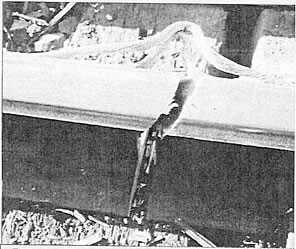

RAIL WAS FOUND BROKEN AGAIN
18 February 2005
 |
 |
RAIL WAS FOUND BROKEN AGAIN |
|
(Union News "Daily DORO CHIBA" No.6021,)(Japanes)
|
|
|
||
RAIL WAS FOUND BROKEN AGAIN!STAND UP FOR STRIKE IN THE SPRING LABOUR OFFENSIVE 2005! RAIL WAS FOUND BROKEN AGAIN!
|
 |
| Picture of broken rail found last year. The same has happened just in a year. |
On 6 January last year, 20 mm crack of rail track was found in Sobu rapid line. And now, one year later, another rail crack was found in the same area in the same line again. This is unacceptable!
It was around 22:05 on 13 February, after departing Tsudanuma station bound for Inage, a train driver found the 2nd blockage traffic signal showing red light. He stopped 1923F train and reported it to a rail commander. An engineer from Shin-Koiwa Maintenance Technology Centre received the commander's notice and supposed that the cause was short-circuiting. He went to investigate the problematic area and found 30 mm crack in the right side rail track of the rapid line bound for Inage, about 28 km and 980 meter point from Tokyo.
The crack was almost in the middle of a longer-type track (1,000-meter) near Makuhari train area. Trains run at fast speed here and the railway curves to the right. It could have been a fatal disaster if the 1923F train failed to stop.
The JR (Japan Railway) had examined track damages with inspection car at Sobu rapid line on 20 January (just 3 weeks before it cracked), and judged the point as "Rank B" according to its replacement note (*).
* JR's note on rank of rail track damage and
track replacement timing
Rank B: Replacement is necessary within 3 months - 6 months at the latest
Rank C: Replacement is necessary within 30 days
Rank CC: Replacement is necessary within 10 days
* Result of damage inspection on 20 January
Rank B: 20 points
Rank C and CC: 8 points (Replacements of these 8 places have been done
already)
They had found "shelling" (metal fatigue phenomenon showing shell-like pattern on the surface of track) and "squeal crack" (oblique-line-shaped flaw caused by the friction between flange of wheels and rail gauge corner) on the track in question, but they ranked it as "B", not requiring urgent replacement.
The track was, abruptly, broken within a month after the inspection in reality and left 30 mm crack. It tells us that they could not give correct and precise judgement only with the inspection car's examination.
It is critical that the same line has had 2 broken rails in just a year.
We had never heard of "broken rail" before the railway privatization and have never even after the privatization so far. Sobu rapid line is "the first grade line" and should have had the best quality. It was impossible to have rail crack considering its weight and strength of rail track. A person in charge of facility maintenance in JR Chiba said "This is beyond our expectation".
But the tracks have been broken. And twice. This is significantly serious matter. As thinking the fact that ordinary Sobu line (which runs parallel to Sobu rapid line) has had no such a problem, JR's decision of speed-up and the extra load for the tracks is the likeliest cause of the cracks. It is JR's Cost-Cut policy and Profit Comes First attitude which is to blame.
Facility and other business were subcontracted at the end of 2001, already 3 years ago. And now, they have lost know-how to maintain rail tracks and skill to organize train time table.
In order to regain driving safety, and to stop another subcontracting, and to win original jobs for compulsively transferred members, let's rise up for strike in Spring Labour Offensive
![]()
|
|
|
|